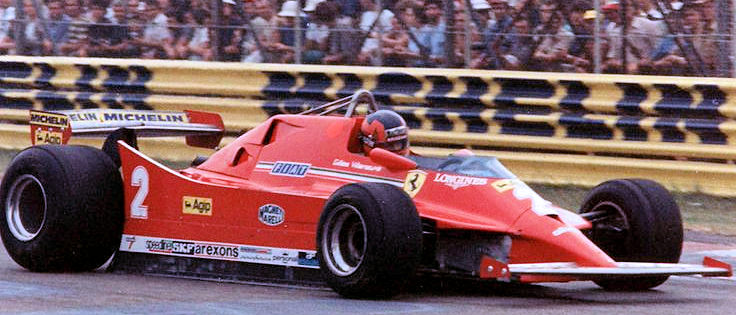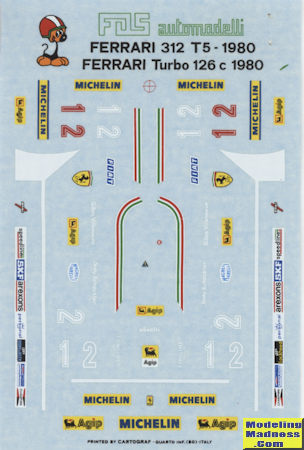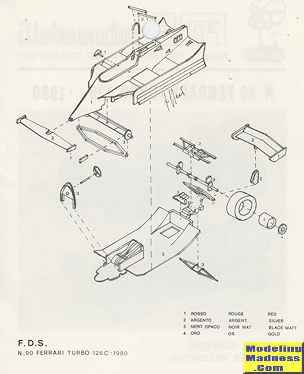
| KIT #: | 90 |
| PRICE: | @$14.00 in 1985 |
| DECALS: | Two options |
| REVIEWER: | Scott Van Aken |
| NOTES: | Cast metal with vacuform windscreen |

| HISTORY |
The Ferrari 126C was designed to replace the highly successful but obsolete 312T series in use since 1975. The basic chassis was almost identical to the previous car but the smaller and narrower V6 turbo engine suited the ground effect aerodynamics now needed to be competitive, and was a better package overall. During engine development Ferrari experimented with a Comprex pressure wave supercharger, however due to packaging issue the engine was finally fitted with twin KKK turbochargers and produced around 600 bhp (447 kW; 608 PS) in qualifying trim, detuned to 550 bhp (410 kW; 558 PS) for the races proper.
The car was first tested during the Italian Grand Prix in 1980. In testing it proved far faster than the 312T5 chassis the team were then using and Gilles Villeneuve preferred it, though he had reservations about the handling. Early unreliability of the turbo engine put paid to Villeneuve's 1981 championship hopes but he did score back to back victories in Monaco and Spain, as well as several podium places. Because of the problematic handling the 126CK was at its best on fast tracks such as Hockenheim, Silverstone, Monza and the Österreichring. The car proved to be very fast but Gilles Villeneuve found the handling to be atrocious, calling the car "a big red Cadillac". According to Villeneuve's teammate Didier Pironi and English engineer Harvey Postlethwaite, who arrived at Ferrari well into the 1981 season, it was not the chassis that was the main cause of the car's handling problems, but the very bad aerodynamics of the car. Postlethwaite later said that the 126CK "had a quarter of the downforce that the Williams or Brabham had that year". The poor aero of the car (coupled to the chassis' hard suspension) created a tendency to make the car slide into corners before the ground effect pulled the car back on to the track. This had the undesired effects of exposing the drivers to even larger g-forces than the Williams FW07 or Brabham BT49 and making the car tend to overuse its tyres. In addition to the very poor aerodynamics of the car, the engine had massive turbo lag, followed by a ferocious power curve; this upset the balance of the chassis; although the engine was the most powerful engine that year, even more so than the Renault. In all it made for a very tricky driving experience. This was particularly the case at the Österreichring where one gaggle of 6 naturally aspirated, better handling cars formed behind Didier Pironi for a number of laps, and then another gaggle of 3 other cars formed behind Pironi shortly afterwards, none of whom could find their way past easily due to the Ferrari's power advantage on the very fast Austrian circuit. The same thing also happened at Jarama that year; 4 cars were stuck behind Villeneuve on the tight and twisty circuit, but he was able to hold off the cars behind him thanks to the car's power advantage.
| THE KIT |
 This
particular kit is one of many FDS kits I bought in the mid-1980s. Over the years
I have built several and can tell you that they are not difficult to build.
Perhaps not as detailed as modern resin multimedia kits of today, but still well
worth seeking as they look nice on the shelf.
This
particular kit is one of many FDS kits I bought in the mid-1980s. Over the years
I have built several and can tell you that they are not difficult to build.
Perhaps not as detailed as modern resin multimedia kits of today, but still well
worth seeking as they look nice on the shelf.
In line with other FDS kits, it comes in a long,
rectangular box. It has a full upper
body with a flat underside section. Some of these sorts of kits screw together,
but not FDS. One is supplied with a rear wing section, front and rear suspension components, a rear view mirror,
exhaust and transmission (the engine is buried under the bodywork), a roll bar assembly, chrome wheels, nice tires (which
I think are supposed to be vinyl, but these seem pretty hard), along with
inserts. It looks like one will have to stretch a bit of sprue for the roll bar
supports
is buried under the bodywork), a roll bar assembly, chrome wheels, nice tires (which
I think are supposed to be vinyl, but these seem pretty hard), along with
inserts. It looks like one will have to stretch a bit of sprue for the roll bar
supports  and
the steering shaft. Usually one gets a section of wire, but not this time. A vacuformed windscreen completes the
kit.
and
the steering shaft. Usually one gets a section of wire, but not this time. A vacuformed windscreen completes the
kit.
Instructions are an exploded diagram with basic painting information in Italian, French, and English. This is fairly typical of these kits from this time frame. Newer kits usually have a lot of photo etch so their instructions are more complex. I am not sure just which race this is supposed to be for, but the box has 1980 printed on it so it may well be the prototype or even the early 1981 season car for the two drivers that year, Jody Schecter and Gilles Villeneuve. Surprisingly, the decal sheet is in quite good condition and printed by a then relatively unknown company called Cartograf. You'll also note that this sheet is for two different cars.
| CONCLUSIONS |
I'm not sure just how popular 1/43 car kits really are. I'm sure that they are a niche group, but there are several plusses to the scale. One is that the kits are generally interesting subjects you cannot (or could not) get in other scales. Secondly, they take up very little shelf space so can be displayed where others won't fit. Finally, they usually take a bit of modeling skill, despite the low parts count. Over the years I've built quite a few and really can recommend them to the enthusiast.
| REFERENCES |
https://en.wikipedia.org/wiki/Ferrari_126C
September 2016 Copyright
ModelingMadness.com. All rights reserved Thanks to me for the review kit. If you would like your product reviewed fairly and fairly quickly, please
contact the editor
or see other details in the
Note to
Contributors.